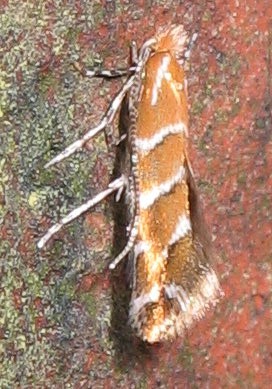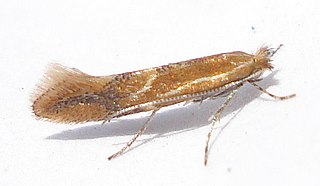Hypermetamorphosis, or heteromorphosis, is a term used mainly in entomology; it refers to a class of variants of holometabolism, that is to say, complete insect metamorphosis. Hypermetamorphosis is exceptional in that some instars, usually larval instars, are functionally and visibly distinct from the rest. The differences between such instars usually reflect transient stages in the life cycle; for instance, one instar might be mobile while it searches for its food supply, while the following instar immediately sheds its locomotory organs and settles down to feed until it is fully grown and ready to change into the reproductive stage, which in turn, does not have the same nutritional requirements as the larvae.

The horse-chestnut leaf miner is a leaf-mining moth of the family Gracillariidae. The horse-chestnut leaf miner was first observed in North Macedonia in 1984, and was described as a new species in 1986. Its larvae are leaf miners on the common horse-chestnut. The horse-chestnut leafminer was first collected and inadvertently pressed in herbarium sheets by the botanist Theodor von Heldreich in central Greece in 1879.

Gracillariidae is an important family of insects in the order Lepidoptera and the principal family of leaf miners that includes several economic, horticultural or recently invasive pest species such as the horse-chestnut leaf miner, Cameraria ohridella.

Cameraria is a genus of moths in the family Gracillariidae, which includes many species of leaf miners. One of the best known species is the horse-chestnut leaf miner, Cameraria ohridella.

Macrosaccus robiniella is a moth of the family Gracillariidae.

Phyllonorycter is a genus of moths in the family Gracillariidae.
Phyllonorycter didymopa is a moth of the family Gracillariidae. It is known from South Africa and Namibia.
Phyllonorycter loxozona is a moth of the family Gracillariidae. It is known from South Africa and Uganda. The record for Kenya is a misidentification of Cameraria torridella.
Phyllonorycter melanosparta is a moth of the family Gracillariidae. It is known from South Africa, Zimbabwe and western Kenya. The habitat consists of secondary woodland where forest flora intermixes with savannah plants.
Phyllonorycter melhaniae is a moth of the family Gracillariidae. It is known from Zimbabwe and South Africa.
Phyllonorycter rhynchosiae is a moth of the family Gracillariidae. It is known from South Africa. The habitat consists of the urban hills of Pretoria.
Neolithocolletis pentadesma is a moth of the family Gracillariidae. It is known from Indonesia (Java), Malaysia, the Philippines (Luzon) and the Seychelles.
Cameraria macrocarpae is a moth of the family Gracillariidae. It is only known from Manitoba, Canada.
Cameraria perodeaui is a moth of the family Gracillariidae. It is found in the Democratic Republic of the Congo in primary rainforest.
Phyllonorycter achilleus is a moth of the family Gracillariidae. It is found in the Albertine Rift and the Kakamega Forest in western Kenya. The habitat consists of tropical rainforests where Guineo-Congolian flora intermixes with savannah plants at altitudes above 1,500 meters.
Phyllonorycter adderis is a moth of the family Gracillariidae. It is found in south-western Rwanda in montane, closed canopy forests at an altitude of about 1,800 metres.
Phyllonorycter gato is a moth of the family Gracillariidae. It is found in south-western Rwanda in open clearings in montane wet forests at an altitude of about 1,800 meters.
Phyllonorycter ocimellus is a moth of the family Gracillariidae. It is found in eastern and western Kenya in humid, secondary forests at an altitude of about 1,600 meters.
Porphyrosela gautengi is a moth of the family Gracillariidae. It is found in South Africa in secondary forests.

Gracillariinae are a subfamily of moths which was described by Henry Tibbats Stainton in 1854.






